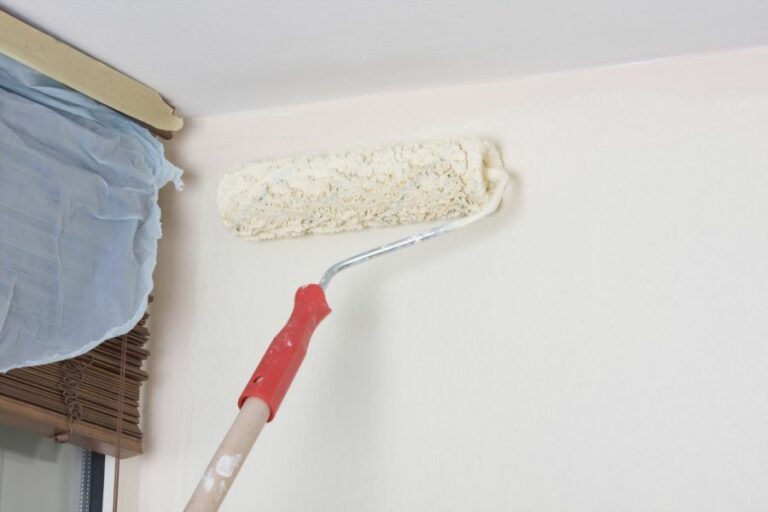How To Caulk And Seal For Even Painting, What Pros Say
Are you tired of uneven paint jobs that leave your space looking unprofessional or haphazard? Fret no more, as we’ve got you covered with essential caulking and sealing tips to ensure a smooth and even finish when painting. With our guidance and expertise, you’ll be able to achieve paint results that you can be truly proud of.
How to caulk and seal for even painting:
To caulk and seal for even painting, choose a paintable acrylic-latex caulk, and clean the surface by removing old caulk and wiping away residue. Load a caulking gun, apply the caulk along the gap, and smooth it out using a damp finger or caulking tool. Allow the caulk to cure for 24 hours before applying paint that is compatible with the chosen caulk.

Unsure how to achieve a smooth finish when painting? Read on to discover step-by-step instructions for caulking and sealing to ensure an even paint job! We’ve got expert tips and tricks to make this DIY project a breeze. Keep reading and transform your space like a pro.
Contents
- 1 Expert Guide: Caulking & Sealing for Smooth Painting Results
- 2 Achieving Flawless Paint Lines using Caulk: Tips & Tricks
- 3 Comparing Methods: Painting Over Caulk vs. Caulking Over Paint
- 4 Applying Caulk Prior to Painting: Step-by-Step Process
- 5 Taping Techniques for Straight Paint Lines: A How-To Guide
Expert Guide: Caulking & Sealing for Smooth Painting Results
• Introduction
Caulking and sealing your surfaces before painting is a crucial step to ensure a professional and polished finish. This process helps fill gaps, cracks, and seams, as well as create a smooth, even surface for the paint to adhere to.
• Materials and Tools Needed
- Caulk or sealant
- Caulking gun
- Putty knife
- Utility knife
- Clean, damp cloth or sponge
- Painters tape (optional)
- Sandpaper (optional)
• Choosing the Right Caulk or Sealant
Selecting the appropriate caulk or sealant is vital for a successful caulking and sealing project. There are various types available, each having specific properties and uses.
For most indoor painting projects, a paintable acrylic-latex caulk is an excellent choice due to its ease of application, minimal shrinkage, and long-lasting flexibility.
Additionally, it is crucial to check the caulk’s label for compatibility with your chosen paint type. If you’re unsure what caulk to use, consult a professional or visit a reputable home improvement website for guidance.
• Preparing the Surface
Before caulking and sealing, ensure that the surface is clean, dry, and free from any debris, dust, or loose paint. Use a utility knife or putty knife to remove old caulk and a damp cloth or sponge to wipe away any dirt or residue. If needed, lightly sand the area to promote better adhesion for the caulk.
• Applying the Caulk
1. Load the Caulking Gun
Cut the tip of the caulk tube at a 45-degree angle, ensuring the opening is not too large to maintain control over the bead size. Puncture the inner seal using a long nail or the wire on the caulking gun. Insert the tube into the caulking gun, making sure it is secure and properly aligned.
2. Apply the Caulk
Starting at one end of the gap or seam, hold the caulking gun at a 45-degree angle and slowly apply steady pressure to the trigger. This will dispense an even bead of caulk along the surface. Ensure that the bead fills the entire gap, but avoid applying excessive caulk, as this will make smoothing more difficult.
3. Smooth the Caulk
Using a damp finger or a specialized caulking tool, smooth the caulk to create an even, seamless appearance. Wipe away any excess caulk with a damp cloth before it dries.
For a cleaner finish, consider using painter’s tape on either side of the seam before applying the caulk. Remove the tape immediately after smoothing the bead, and gently clean up any residue.
• Allow the Caulk to Cure
Refer to the caulk’s label for specific drying times before applying any paint. Most products require at least 24 hours to cure fully. During this time, avoid touching or applying pressure to the caulk to prevent any damage or unevenness.
• Painting Over the Caulk
Once the caulk has fully cured, the surface is ready for painting. Ensure that the paint is compatible with the type of caulk used and follow the paint manufacturer’s instructions for application. Applying a primer coat may be necessary for a more even, durable finish.
• Conclusion
Caulking and sealing your surfaces might seem like an extra step, but it is essential for creating a professional and even paint finish.
By selecting the appropriate caulk or sealant, preparing the surface, and following the steps outlined in this article, you can enhance the longevity and appearance of your paint job.
Step | Description |
|---|---|
1 | Remove any old caulk and debris from the area you will be sealing. |
2 | Thoroughly clean and dry the area to ensure proper adhesion of the new caulk. |
3 | Choose the appropriate type of caulk for the project (e.g., acrylic-latex or silicone-based). |
4 | Apply painter’s tape on both sides of the gap to ensure clean, straight lines. |
5 | Cut the caulk tube’s nozzle at a 45-degree angle and insert it into a caulking gun. |
6 | Apply steady pressure to the caulking gun as you apply a continuous bead of caulk along the gap. |
7 | Smooth the caulk with a wet finger, a caulking tool, or a moistened sponge to create an even, professional appearance. |
8 | Remove the painter’s tape immediately to avoid peeling any dried caulk. |
9 | Allow the caulk to dry and cure according to the manufacturer’s instructions before painting. |
10 | Apply paint over the caulked and sealed areas using the desired painting technique. |
Achieving Flawless Paint Lines using Caulk: Tips & Tricks
Creating perfect paint lines with caulk is a skill that can elevate the quality of any paint job. By using caulk, you can avoid the dreaded problem of paint bleeding through your tape lines, resulting in crisp, clean edges.
• Gather Your Supplies
Before starting the project, be sure to have the right supplies on hand. These are the essential items you’ll need:
- Painter’s tape
- High-quality latex caulk
- A caulk gun
- A damp cloth or sponge
- A putty knife or a plastic card
- A good quality paintbrush or roller
- Paint of your chosen color
Having everything prepared in advance will make the process smoother and prevent unnecessary interruptions.
• Prep the Area
Thoroughly clean your surface, ensuring it is free from dirt, dust, and grease. Wipe it down with a damp cloth or sponge and allow it to dry completely. Inspect the wall for any imperfections, such as cracks or nail holes.
If necessary, repair these using filler as per the manufacturer’s instructions. Once the repairs are complete and the surface is clean and dry, you are ready to begin.
• Apply Painter’s Tape
Begin by applying painter’s tape to your surface, ensuring the edges are straight and evenly pressed down. Be sure to use high-quality painter’s tape, as it is less likely to allow the paint to seep underneath. Take your time and be precise. This step is crucial to achieving perfect paint lines.
• Apply Caulk
Now that your surface is prepped and taped, it’s time to apply the caulk. Use latex caulk, as it is water-soluble and easier to work with than silicone caulk. Load your caulk gun and cut the tip at a 45-degree angle.
Starting in a corner, gently squeeze the trigger and apply a thin bead of caulk along the edge of the painter’s tape. Make sure you apply an even, continuous bead to prevent gaps and ensure a crisp paint line.
• Smooth the Caulk
Next, use a putty knife or a plastic card to gently smooth the caulk along the edge of the tape. This step ensures the caulk effectively fills any gaps between the tape and the wall.
Be sure to remove any excess caulk, as leaving it will result in an uneven paint line. A damp cloth or sponge can be helpful at this stage too.
• Allow the Caulk to Set
Once you’ve applied and smoothed the caulk, allow it to set for a short time. You don’t want it to dry completely, as you will need to remove the tape before that point. Refer to the instructions on your specific caulk’s packaging for guidance, but generally, around 20-30 minutes should suffice.
• Paint Over the Caulk
While the caulk is still setting, paint your surface with your chosen color. Apply the paint with a good-quality brush or roller, making sure to cover the caulked areas evenly. Be careful not to apply too much pressure when painting close to the caulked edges, as this may cause paint to seep under the tape.
• Remove the Painter’s Tape
Once you have finished painting, you will need to remove the painter’s tape. This step is essential for creating those crisp, clean lines. Carefully peel back the tape at a 45-degree angle, taking care not to damage the paint or the surface underneath. Proceed slowly and keep a steady hand to avoid smudging your paint lines.
• Admire Your Results
Congratulations, you have now created perfect paint lines with caulk! By following these steps, you have achieved professional-quality results that will impress anyone who sees them.
For more information and helpful tips on painting, Princeton’s Painting and Decorating page provides additional resources.
In conclusion, making perfect paint lines with caulk may require some extra time and care. However, the results speak for themselves. Allow yourself plenty of time and patience, and with a bit of practice, you’ll soon be able to create crisp, flawless paint lines every time.
Step | Description |
|---|---|
1 | Prepare the surface by cleaning it and ensuring it is dry and free of dust. |
2 | Apply painter’s tape along the edge where you want the perfect paint line. |
3 | Apply a thin bead of paintable caulk on the edge of the tape where it meets the wall. |
4 | Smooth the caulk with a damp finger or putty knife, pressing it into the edge of the tape and removing excess caulk. |
5 | Allow the caulk to dry slightly but not completely (about 5-10 minutes). |
6 | Paint the wall using a brush or roller, painting over the caulk and onto the tape. |
7 | While the paint is still wet, carefully remove the painter’s tape, revealing a clean, sharp paint line. |
Comparing Methods: Painting Over Caulk vs. Caulking Over Paint
Deciding whether to paint over caulk or caulk over paint is a common dilemma faced by DIY enthusiasts and professional painters alike.
• The Roles of Paint and Caulk
– Role of Paint
Paint serves several purposes in a home improvement project, including:
- Aesthetics: Providing color and finish to beautify and harmonize the space.
- Protection: Creating a barrier that protects the surface from moisture, UV radiation, and external elements.
- Structural integrity: Enhancing the durability and longevity of the surface.
– Role of Caulk
Caulk is a sealant material that is used to fill gaps, seams, and joints in various substrates (e.g., wood, drywall, concrete, etc.). Its primary purposes are:
- Preventing water infiltration: Sealing cracks and gaps helps to avert water damage, which might lead to rot, mold, and structural issues.
- Enhancing insulation: Filling gaps can significantly improve energy efficiency by reducing drafts and heat loss.
- Achieving a professional finish: A smooth, consistent, and gap-free surface produces a polished and flawless final appearance.
Now that we understand the roles of paint and caulk, let’s explore the pros and cons of painting over the caulk and caulking over paint.
• Painting Over Caulk
– Pros
- Sealed gaps prior to painting: This ensures that moisture, dust, and other contaminants cannot enter the material through the unprotected gaps.
- Better aesthetics: A properly applied and smoothed caulk can produce a cleaner edge and smoother surface for painting. This can improve the final appearance of the painted surface.
- Enhanced durability: Painting over caulk can increase the sealant’s longevity, protecting it from UV degradation and environmental wear.
– Cons
- Paired life expectancy: If the lifespan of the caulk is shorter than that of the paint, the paint can crack and peel along with the deteriorating caulk.
- Adhesion issues: Some caulk, especially silicone-based, can be difficult to adhere to paint properly, leading to uneven surfaces, peeling, or bubbling.
• Caulking Over Paint
– Pros
- Improved seal: Caulking over paint can provide an additional layer of protection against drafts, heat loss, and moisture infiltration.
- Better finish: If the paint has already dried and cured, applying caulk on the surface ensures a smooth, even finish that matches the surrounding area.
- Extended lifespan: Depending on the type and quality of the paint, caulking over it may help extend its life, provided that the caulk adheres effectively.
– Cons
- Uncured paint: Applying caulk on uncured paint can result in lifting or compromised adhesion of the paint, which could affect the appearance and longevity of the finished product.
- Damage over time: If the paint underneath the caulk starts to deteriorate, the caulk may separate from the surface and require reapplication.
• Making the Right Choice
To determine which option works best for your project, consider these factors:
- Material compatibility: Ensure that the caulk is compatible with the type of paint you’re using. Acrylic latex paint tends to adhere better to latex-based caulks than oil or silicone-based caulks. When using a silicone-based caulk, opt for a paintable version to improve adhesion.
- Surface preparation: Properly cleaning, dusting, and priming the surface before applying caulk or paint can significantly enhance adhesion and overall results. Refer to the manufacturer’s instructions for specific guidelines on surface preparation.
- Humidity and ambient conditions: Painting and caulking should be done in dry, well-ventilated conditions. High humidity or temperature fluctuations can impact the curing times and adhesion of both materials.
From my experience, I recommend painting over properly applied and cured caulk for most projects, provided that the caulk is compatible with the paint type.
This approach yields a better aesthetic appearance, a more durable outcome, and greater protection against moisture and environmental elements.
For additional guidance, consult this resource from Purdue University Extension, which offers expert advice on selecting and using paint and caulk in a variety of applications.
By following these guidelines and recommendations, you can confidently make the right decision for your project, producing a professional, long-lasting, and visually pleasing result.
Applying Caulk Prior to Painting: Step-by-Step Process
• Importance of Caulking
Caulking is an essential step in preparation for painting, as it helps to seal gaps and cracks, improve energy efficiency, and prevent water damage. By diligently applying caulking before painting a room or structure, you increase the overall durability and longevity of your paint job.
• Choosing the Right Caulk
Selecting the correct caulk for your project is vital, as different types of caulk are better suited for specific tasks. Here are some common types of caulks:
- Silicone Caulk: Ideal for sealing gaps around windows, doors, and non-porous surfaces. Resistant to water, temperature, and mildew.
- Acrylic Latex Caulk: Perfect for sealing gaps around wood trim, baseboards, and other indoor projects. This type of caulk can be painted over.
- Polyurethane Caulk: Recommended for exterior applications, such as sealing gaps around doors, windows, and siding. It’s highly resistant to weathering.
To ensure a smooth paint job, opt for a paintable caulk. You can also check the label on the caulking tube for guidance on paint compatibility.
• Materials and Tools Needed
To efficiently apply caulking before painting, gather the following materials and tools:
- Caulk (paintable)
- Caulking gun
- Utility knife
- Cloth or rag
- Mineral spirits or water (depending on the caulk type)
- Painter’s tape
- Putty knife
- Prepare the Surface
• Preparing the Surface
To ensure proper adhesion of the caulk, start by cleaning the surface thoroughly. Remove any dirt, dust, and debris from the areas you plan to caulk. If the old caulk is present, use a utility knife or putty knife to carefully remove it.
Once the surface is clean and dry, apply painter’s tape on either side of the gap you’ll be caulking. This helps to create a neat, clean edge and avoids excess caulk on the surrounding surfaces.
• Applying the Caulk
- Cut the Caulk Tube: Use a utility knife to cut the tip of the caulk tube at a 45-degree angle. This allows for easier, more controlled application. Ensure that the opening size matches the size of the gap you’re filling so you don’t apply too much or too little caulk.
- Load the Caulking Gun: Insert the caulk tube into the caulking gun and push the plunger tightly against the tube’s bottom. Cut off the tip of the caulking tube to create a small hole.
- Apply the Caulk: Hold the caulking gun at a 45-degree angle and place the tip of the tube on one end of the gap. Squeeze the trigger of the caulking gun while applying steady pressure, moving the gun smoothly along the gap. Remember to release the pressure when you reach the other end to avoid excess caulk from coming out.
- Smooth the Caulk: Use a wet finger, damp cloth or sponge, or a caulk smoothing tool to smoothen the caulk line, ensuring that it fully fills the gap and creates a smooth, even surface. Perform this step immediately, as caulk begins to dry and harden quickly.
- Remove Painter’s Tape: Carefully remove the painter’s tape before the caulk dries. This will help create a clean and sharp line when painting.
• Drying and Painting
After you have applied the caulk, let it dry thoroughly. The drying time will be specified on the caulk packaging, but generally, it takes at least 24 hours for caulk to cure fully. Before painting over the caulk, ensure it’s completely dry and hard to touch.
Once dried, you can proceed with your painting project, confident that the gaps and cracks have been properly sealed.
• Conclusion
Caulking before painting is a crucial step to achieving a professional, long-lasting result. By choosing the right caulk, preparing the surface, and applying the caulk correctly, you’ll create a durable and smooth paint job.
For more information on best practices for caulking in painted structures, visit the U.S. Department of Energy’s webpage on Caulking.
| How do you apply caulking before painting? | |
|---|---|
| 1. Gather materials | Gather the necessary tools and materials, such as a caulking gun, caulk, and painter’s tape. |
| 2. Prepare the surface | Clean the surfaces to be caulked, removing any dirt, debris, or old caulk. Make sure the area is dry and free of dust. |
| 3. Apply painter’s tape | Apply painter’s tape along the edges of the surfaces where you want to apply caulk, leaving a small gap for the caulk to be applied. |
| 4. Cut the caulk tube tip | Cut the tip of the caulk tube at a 45-degree angle, making sure the opening is the right size for the gap you want to fill. |
| 5. Load caulk gun | Insert the caulk tube into the caulking gun and make sure it’s locked in place. |
| 6. Apply caulk | Apply the caulk in a continuous bead along the gap between the taped edges, holding the gun at a consistent angle while applying even pressure to the trigger. |
| 7. Smooth the caulk | Wet your finger or use a smoothing tool to smooth the caulk into the gap, giving it a clean finish against the surfaces. |
| 8. Remove painter’s tape | Remove the painter’s tape carefully while the caulk is still wet to ensure clean lines. |
| 9. Allow caulk to dry | Allow the caulk to dry according to the manufacturer’s instructions before painting. |
Taping Techniques for Straight Paint Lines: A How-To Guide
Whether you’re repainting a room, applying a fresh coat on furniture, or creating a detailed design on canvas, taping off straight lines is a crucial step in achieving professional-quality results.
• The Importance of a Straight Line in Painting
Creating straight lines in your painting project is essential to achieving a polished, professional look. When executed correctly, it brings a sense of harmony and balance to the overall design.
It’s especially important in interior painting projects, where clean lines along baseboards, moldings, and ceilings are crucial to maintaining the aesthetic appeal of the space.
Straight lines are also vital in decorative painting, such as creating geometric patterns or implementing borders on furniture or murals. Properly taped lines prevent paint bleeding, minimizing touch-ups and rework post-painting.
For more information on the importance of straight lines in art and design, check out this resource from the University of Nebraska-Lincoln.
• Choosing High-Quality Painter’s Tape
I recommend using high-quality painter’s tape for your project. This specialized adhesive tape is specifically designed to prevent paint bleed and damage to the surface when removed. There are various painter’s tape options available, such as multi-surface, delicate, and exterior tapes.
The key factors to consider when choosing painter’s tape are the surface you’ll be applying the tape to, the level of adhesion required, and the duration of the project.
Delicate tapes are recommended for freshly painted or fragile surfaces, while multi-surface tapes can be used on various materials such as wood, glass, and metal.
• Prepping the Surface
Before taping off the straight lines, ensure the surface is clean, dry, and dust-free. The presence of dirt, grease, or moisture on the surface can compromise the tape’s adhesion, increasing the chances of paint bleed and uneven lines.
Start by wiping down the area you’ll be painting with a clean, damp cloth to remove dirt and dust. For greasier surfaces, use a degreaser or mild detergent to clean the area, then rinse with water and allow it to dry thoroughly.
Imperfections on the surface, such as holes, cracks, or peeling paint, should be repaired and sanded down to create a smooth, uniform workspace.
• Taping Techniques for Straight Lines
Now that the surface is prepped and the appropriate painter’s tape has been selected, it’s time to apply the tape and create clean, straight lines for your painting project. Follow these steps for optimal results:
- Measure and Mark: If precise measurements are needed, use a measuring tape, ruler, or level to mark the desired position of the tape. You may use a pencil for light markings that can be erased or painted over.
- Apply the Tape: Begin applying the painter’s tape at one end of the marked line. Unroll the tape slowly while keeping it taut, ensuring the edge aligns with the guideline. Press down firmly on the tape’s edge as you go.
- Smooth Out the Tape: Once the tape is applied and aligned, use a flat edge like a plastic scraper, credit card, or your fingers to smooth out any bubbles or creases. This step ensures strong adhesion, reducing the risk of paint bleeding under the tape.
- Trim Excess Tape: When a corner or endpoint is reached, use scissors or a utility knife to carefully trim the tape to the desired length. Be cautious not to damage the surface beneath.
For curves or intricate designs, consider using flexible tape or cutting the tape into smaller pieces and overlapping them to conform to the shape.
• Painting and Removing the Tape
With the tape in place and the edges properly sealed, it’s time to paint. Use a brush or roller to apply the paint, being mindful of the taped edges. Start by painting away from the tape’s edge, then gradually move inwards with light strokes to minimize the chance of paint seeping under the tape.
Once you have completed painting, wait for the paint to dry to the touch before removing the tape. This prevents smudging or dripping yet avoids the risk of the tape becoming difficult to remove.
Pull the tape off slowly, maintaining a consistent angle of about 45 degrees away from the painted edge. If you notice any paint creeping under the tape, use a utility knife or razor to lightly score the paint along the tape’s edge without cutting into the surface beneath.
• Final Thoughts
Taping off straight lines is a critical aspect of achieving a professional finish in your painting projects. With the proper surface preparation, tape selection, and technique, you can accomplish clean and precise lines every time.
Remember that practice makes perfect, and with time, your skills in taping and painting will only improve.
Step | Description |
|---|---|
1 | Choose the right painter’s tape for your project, picking a suitable width and type. |
2 | Clean the surface you will be applying the tape to, removing any dust or debris. |
3 | Measure and mark where you want the straight lines to be using a ruler, level, or straight edge. |
4 | Start at one end and apply the painter’s tape along the marked lines, leaving a slight overhang at the ends. |
5 | Smooth out the tape with your fingers or a flat edge, making sure it adheres well to the surface. |
6 | Reinforce the edge of the tape by running a putty knife or similar tool along the edge to create a better seal. |
7 | Paint the area with your desired color, feathering the paint slightly over the edge of the tape to prevent gaps. |
8 | Allow the paint to dry partially but not completely, then carefully remove the tape by pulling it back on itself at a 45-degree angle. |
9 | Touch up any imperfections in the paint lines with a small brush or cotton swab. |







